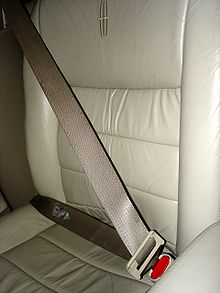
Sash
A "sash" or shoulder harness is a strap that goes diagonally over the vehicle occupant's outboard shoulder and is buckled inboard of his or her lap. The shoulder harness may attach to the lap belt tongue, or it may have a tongue and buckle completely separate from those of the lap belt. Shoulder harnesses of this separate or semi-separate type were installed in conjunction with lap belts in the outboard front seating positions of many vehicles in the North American market starting at the inception of the shoulder belt requirement of the U.S. National Highway Traffic Safety Administration's Federal Motor Vehicle Safety Standard 208 on 1 January 1968.
Seat-Belt Design Played Role in Asiana Crash Injuries
Doctors Treating Victims of San Francisco Plane Crash Cite Trauma From Lap Belts; Some Asiana Business-Class Seats Have Rare Chest Harnesses
As of Wednesday, at least 16 of the flight's 307 passengers and crew remained hospitalized after Saturday's crash landing at San Francisco International Airport. Four of those were in critical condition at San Francisco General Hospital and Stanford Hospital and Clinics in Palo Alto, Calif. Two 16-year-old girls were killed; authorities said it was possible one of them was run over by a firetruck responding to the scene as she lay on the tarmac. Autopsy reports weren't yet released on the cause of the death for the girl, identified by the San Mateo County coroner as Ye Mengyuan.
Related
- 911 Calls Detail Moments After Crash
- 90 Seconds Passed Before Evacuation Order
- Pilots' Recollections Differ From Recordings
- FAA to Tighten Rules on Co-Pilots
- Runway Shift Might Have Helped Avert Greater Disaster
- Asiana's Response to Crash Draws Notice
- Religious Ties Concern Parents of Chinese Students
- The Middle Seat: Baggage-Toting Fliers Threaten Evacuations
- An Airbag for Your Plane Seat
In contrast, at least one passenger in the business-class section of the Asiana jet had a seat equipped with a chest harness. Eugene Anthony Rah, a 46-year-old entertainment producer and promoter from South Korea who was seated in business class, said he believes the chest harness prevented him from being seriously injured.
At St. Mary's Medical Center in San Francisco, surgeon Dimitriy Kondrashov said he treated an elderly crash victim who had four major spinal fractures and one minor fracture. "Because there was no shoulder component to his seat belt, that allowed him to violently slam [his] forehead into the seat in front of him, and then this resulted in some head trauma," Dr. Kondrashov said. The stress of the blow to his head "dissipated across his neck, and that's why he sustained a very unstable fracture of his cervical spine," he added. He said the patient, whose name wasn't made public, was released Tuesday.
San Francisco General received several patients with "seat-belt signs," said Dave Staconis, nurse-manager of the facility's emergency department. Such signs indicate trauma, such as bruising, "across the abdomen, where somebody would wear a lap belt," he said.
Chest harnesses are rare for airplane passengers. They tend to be used in seats where passengers could slam into a bulkhead or a lie-flat bed pod without them, industry experts said. Restraints for pilots and flight attendants are commonly designed with chest harnesses.
Widespread installation of chest harnesses is deemed impractical, experts said, in part because seats would have to be redesigned with rigid seat backs to hold passengers during a crash. Seats where lap belts are used are now designed so that in a crash, passengers are cushioned by the seats in front of them. The seat back is designed to fall forward, absorbing the blow. Such a redesign would add to seats' weight and require a heavier mounting system and floor frame, experts said.
William McGee, an author on aviation based in New York, said he believes airlines have been hesitant to install chest harnesses for everyone because the belts' weight and equipment needed to secure them would add to fuel costs.
An Asiana spokesman said the Korean airline installs harness belts only in certain areas of business class where soft material such as a seat in front isn't available to cushion a passenger's impact. "In certain areas of business class the surroundings are hard material," said the spokesman, who declined to be identified. "In those areas, harness belts are needed." The spokesman added the harness belt holders would protrude in economy-class seats, presenting a possible danger to passengers. As the belt situation now stands, he said, "Regardless of whether it's a lap belt or a harness, protection is guaranteed."
If many of the Asiana passengers sustained abdominal injuries, it's not surprising, industry experts said. The forceful motion of the crash put pressure on the seat belts, which could have shifted upward to a passenger's abdomen from the pelvis, where the belts are intended to be positioned for restraint.
Industry experts said the Asiana plane, a Boeing BA +1.31% 777, had a significant advantage over older models: It was equipped with a new generation of seats, the majority of which stayed in place instead of breaking loose from their floor tracks or collapsing, which could have caused many more serious injuries. In 1988, the Federal Aviation Administration began requiring that seats on newly designed, newly certified planes must withstand inertial force equal to 16 times the force of gravity in static testing. Today, that is the world standard. The FAA declined to make a seat specialist available for an interview.
Still, there is no assurance wearing a chest harness would prevent injury. When cars changed from lap belts to shoulder harnesses, "what that ended up doing was changing the nature of the injury," said Geoffrey Manley, chief of neurosurgery at San Francisco General. "We saw the injuries moving up higher."
—Zusha Elinson, Kanga Kong and Susan Carey contributed to this article.








沒有留言:
張貼留言